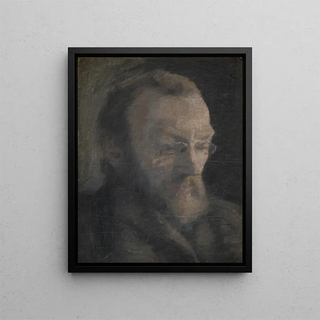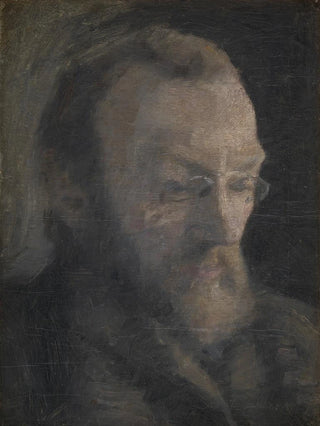Art print | L'historian of art Karl Madsen, later director of the Statens Museum for Kunst - Vilhelm Hammershøi


View from behind

Frame (optional)
Art print of the art historian Karl Madsen, later director of the Statens Museum for Kunst - Vilhelm Hammershøi – Captivating introduction
In the art world, some works manage to capture the very essence of their era while transcending the limits of time. The art print of "L'historien de l'art Karl Madsen, plus tard directeur du Statens Museum for Kunst - Vilhelm Hammershøi" is a perfect example. This piece does more than depict a character; it evokes an atmosphere, a reflection on the very nature of art and history. Through Karl Madsen's penetrating gaze, Hammershøi invites us to explore the intricacies of a rich and complex artistic thought, immersing us in a universe where light and shadow dance harmoniously.
Style and uniqueness of the work
Hammershøi's style is immediately recognizable, characterized by a palette of soft colors and minimalist compositions that reveal great depth. In this art print, the portrait of Karl Madsen is treated with particular delicacy. The clean lines and subtle contours highlight not only the face of the art historian but also the intensity of his gaze. The latter seems to scrutinize the horizon, as if in search of hidden truths. Light plays a crucial role, illuminating certain parts of the scene while leaving others in shadow, creating a play of contrasts that invites contemplation. This stylistic choice demonstrates Hammershøi's mastery in capturing the moment, while leaving room for the viewer's imagination.
The artist and his influence
Vilhelm Hammershøi, an emblematic figure of Danish painting in the early 20th century, established himself as an undisputed master of light and space. His work is distinguished by an introspective approach, often centered on themes such as solitude and intimacy. By painting Karl Madsen, he does not merely depict an art historian; he also immortalizes a moment of encounter between art and critical thought. Hammershøi influenced many contemporary artists, who see in him a pioneer

Matte finish

View from behind

Frame (optional)
Art print of the art historian Karl Madsen, later director of the Statens Museum for Kunst - Vilhelm Hammershøi – Captivating introduction
In the art world, some works manage to capture the very essence of their era while transcending the limits of time. The art print of "L'historien de l'art Karl Madsen, plus tard directeur du Statens Museum for Kunst - Vilhelm Hammershøi" is a perfect example. This piece does more than depict a character; it evokes an atmosphere, a reflection on the very nature of art and history. Through Karl Madsen's penetrating gaze, Hammershøi invites us to explore the intricacies of a rich and complex artistic thought, immersing us in a universe where light and shadow dance harmoniously.
Style and uniqueness of the work
Hammershøi's style is immediately recognizable, characterized by a palette of soft colors and minimalist compositions that reveal great depth. In this art print, the portrait of Karl Madsen is treated with particular delicacy. The clean lines and subtle contours highlight not only the face of the art historian but also the intensity of his gaze. The latter seems to scrutinize the horizon, as if in search of hidden truths. Light plays a crucial role, illuminating certain parts of the scene while leaving others in shadow, creating a play of contrasts that invites contemplation. This stylistic choice demonstrates Hammershøi's mastery in capturing the moment, while leaving room for the viewer's imagination.
The artist and his influence
Vilhelm Hammershøi, an emblematic figure of Danish painting in the early 20th century, established himself as an undisputed master of light and space. His work is distinguished by an introspective approach, often centered on themes such as solitude and intimacy. By painting Karl Madsen, he does not merely depict an art historian; he also immortalizes a moment of encounter between art and critical thought. Hammershøi influenced many contemporary artists, who see in him a pioneer






